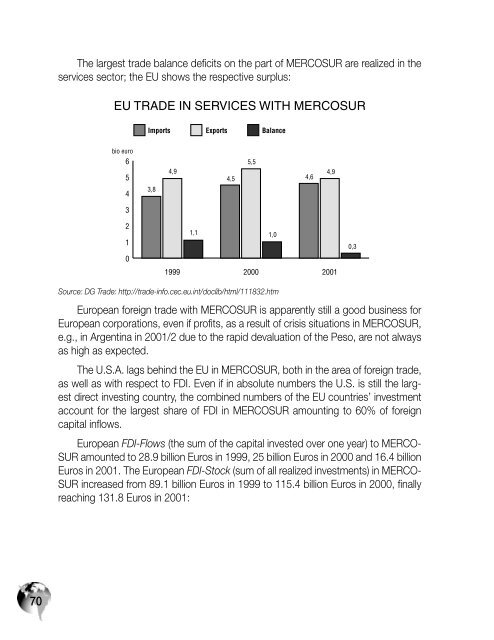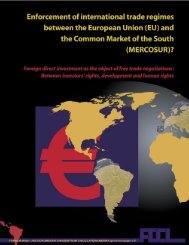Download - FDCL
Download - FDCL
Download - FDCL
You also want an ePaper? Increase the reach of your titles
YUMPU automatically turns print PDFs into web optimized ePapers that Google loves.
70<br />
The largest trade balance deficits on the part of MERCOSUR are realized in the<br />
services sector; the EU shows the respective surplus:<br />
EU TRADE IN SERVICES WITH MERCOSUR<br />
<br />
<br />
<br />
<br />
<br />
<br />
<br />
<br />
<br />
<br />
<br />
<br />
<br />
<br />
<br />
<br />
Source: DG Trade: http://trade-info.cec.eu.int/doclib/html/111832.htm<br />
European foreign trade with MERCOSUR is apparently still a good business for<br />
European corporations, even if profits, as a result of crisis situations in MERCOSUR,<br />
e.g., in Argentina in 2001/2 due to the rapid devaluation of the Peso, are not always<br />
as high as expected.<br />
The U.S.A. lags behind the EU in MERCOSUR, both in the area of foreign trade,<br />
as well as with respect to FDI. Even if in absolute numbers the U.S. is still the largest<br />
direct investing country, the combined numbers of the EU countries’ investment<br />
account for the largest share of FDI in MERCOSUR amounting to 60% of foreign<br />
capital inflows.<br />
European FDI-Flows (the sum of the capital invested over one year) to MERCO-<br />
SUR amounted to 28.9 billion Euros in 1999, 25 billion Euros in 2000 and 16.4 billion<br />
Euros in 2001. The European FDI-Stock (sum of all realized investments) in MERCO-<br />
SUR increased from 89.1 billion Euros in 1999 to 115.4 billion Euros in 2000, finally<br />
reaching 131.8 Euros in 2001:









